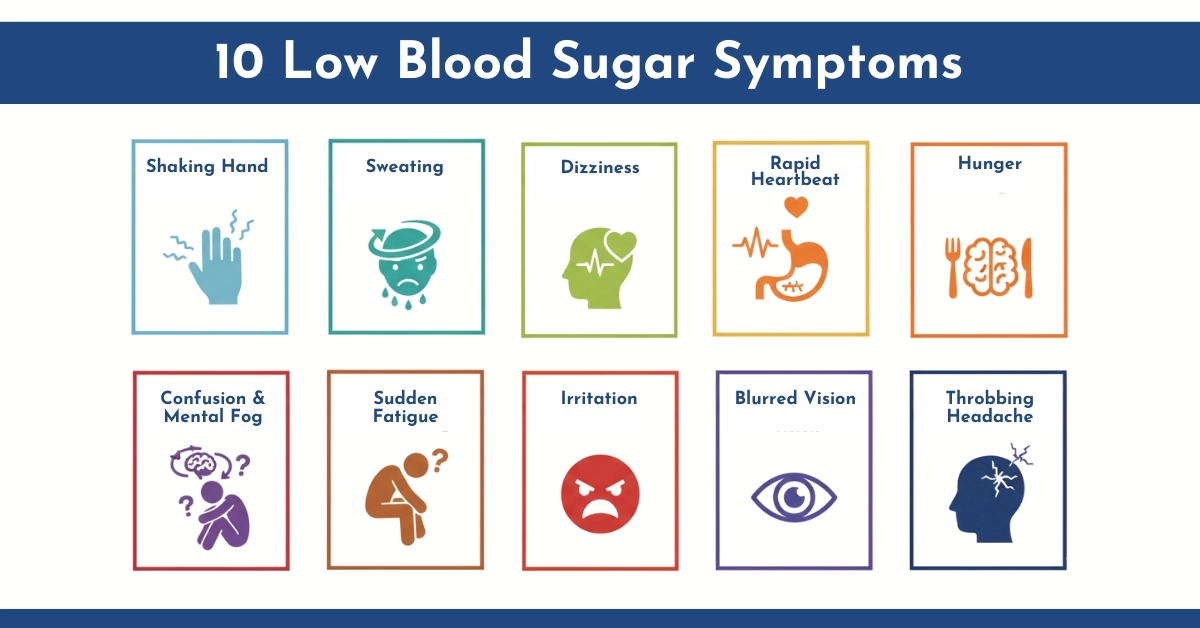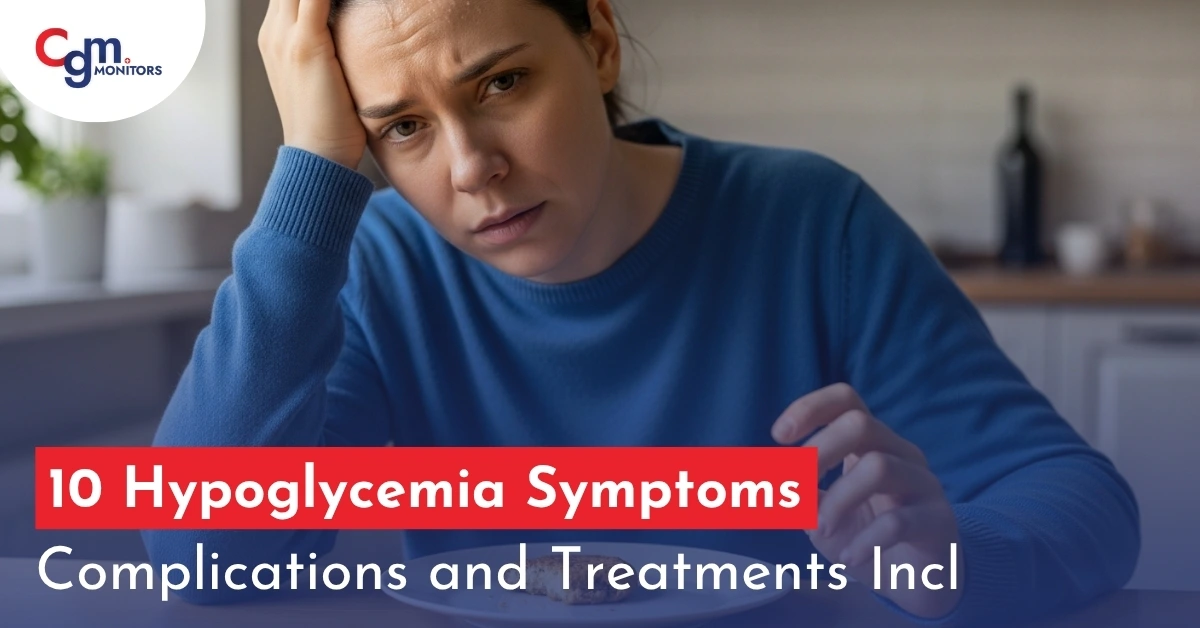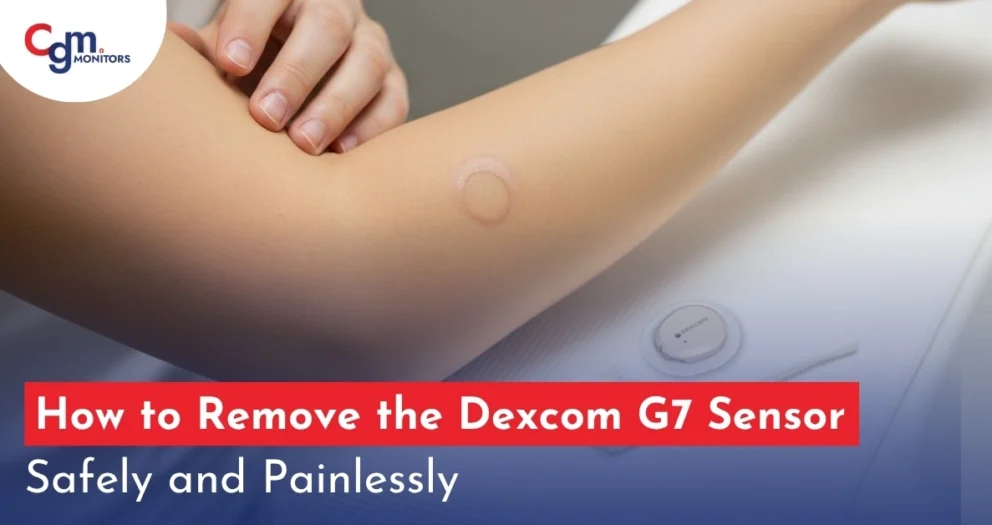Table of content
Hypoglycemia (low blood sugar) is a serious and potentially life-threatening condition. It can have numerous symptoms, and if not treated well, it can lead to severe complications such as seizures, coma, and even death. The following are some hypoglycemia symptoms, connected risks, followed by a short table of managing adverse low glucose events.
Low Blood Sugar Symptoms (Hypoglycemia)
The following are some symptoms of hypoglycemia:
1. Shaking So Bad You Can’t Control It
- Cause: Adrenaline release as your body tries to correct low glucose.
- Risk: Loss of control and accidents.
2. Sweating Like You’ve Run a Marathon
- Cause: Stress response to low glucose.
- Risk: Could lead to hypoglycemic shock.
Foods rich in soluble fiber, such as eggs, oats, nuts, and berries (like bananas), can help manage low blood sugar.
3. Dizziness That Feels Like the Room is Spinning
- Cause: Insufficient glucose supply to the brain.
- Risk: Falls and injuries, especially in vulnerable individuals (elderly, children).
4. Rapid Heartbeat That Could Feel Like a Panic Attack
- Cause: Body releases stress hormones (adrenaline) to correct low blood sugar.
- Risk: Heart strain and increased cardiovascular risk.
Extreme low blood sugar events need emergency help (like glucagon injection).
5. The Hunger That Feels Like You’re Starving
- Cause: The body’s natural signal to raise glucose levels.
- Risk: Overeating, causing glucose spikes later.
6. Confusion and Mental Fog That Can Lead to Dangerous Decisions
- Cause: The brain runs on glucose, and low levels impair thinking.
- Risk: Accidents and poor decision-making.
7. Sudden Fatigue or Complete Weakness
- Cause: Your muscles and organs are running out of energy.
- Risk: Inability to respond to worsening symptoms.
A continuous glucose monitoring device like the Dexcom G7 sensor can save you and your loved ones from adverse low blood sugar events by alerting you 15 minutes before your sugar even goes low.
8. Irritability That Can Turn Into Full-On Rage
- Cause: Hormonal fluctuations and glucose deprivation affecting mood.
- Risk: Personal and professional strain due to extreme mood swings.
9. Blurred Vision That Makes Everything Look Like a Mess
- Cause: Low blood glucose impairs eye function temporarily.
- Risk: Disorientation, accidents, car crashes.
10. A Throbbing Headache That Won’t Quit
- Cause: Brain’s glucose deprivation leads to headaches.
- Risk: Inability to focus and missed tasks.
11. Seizures That Can Put Your Life in Danger
- Cause: Extremely low glucose levels disrupt brain function.
- Risk: Severe injury or death if not treated immediately.

Do NOT Ignore Hypoglycemia
While rare, prolonged and severe hypoglycemia can cause brain damage or death.
Immediate Treatment and Emergency Solutions
The table below is for treating emergency hypoglycemic events:
| Treatment Option | How it Helps | Emergency Use |
| Glucose Tablets/Gel | Provides quick energy to raise glucose | Best for immediate hypoglycemic episodes |
| Fruit Juice/Regular Soda | Raises blood sugar fast | Quick fix if you don’t have glucose tabs |
| Hard Candies/Sugar | Offers rapid sugar boost | Short-term emergency solution |
If your blood sugar is still below 70mg/dL, monitor your blood sugar every 15 minutes until it returns to normal.
Follow-Up Actions After Treatment
Always follow up with a balanced meal containing complex carbohydrates and protein to maintain stable glucose levels. CGM Monitors help track glucose levels continuously, alerting you before your blood sugar drops too low. They are essential for preventing loss of consciousness or seizures from unexpected hypoglycemia.
Conclusion:
People with diabetes should regularly monitor their glucose to prevent blood sugar drops. Hypoglycemia is not just about feeling hungry. It can escalate into life-threatening situations like seizures, loss of consciousness, or death. Glucose tablets for hypoglycemia are crucial for immediate treatment, and investing in a CGM device is a smart move for managing your blood sugar levels effectively. Stay informed, stay proactive, and take control of your health to avoid these extreme risks.
Disclaimer: This blog is for informational purposes only and does not constitute medical, legal, or professional advice. While we strive for accuracy, errors or omissions may occur.
Some images in this blog may be AI-generated or for illustrative purposes only. Device images belong to their respective manufacturers and are used here for reference. Actual products may vary.
Frequently Asked Questions
Can you be hypoglycemic without having diabetes?
Yes. Non-diabetic hypoglycemia can occur due to certain medications, hormonal imbalances, long fasting periods, or excessive alcohol intake.
What should a hypoglycemic person eat?
Quick sources of glucose like fruit juice, regular soda, glucose tablets, or candy can raise blood sugar immediately. Follow up with a balanced snack containing protein and complex carbohydrates.
What is the 15-15 rule for hypoglycemia?
It means consuming 15 grams of fast-acting carbohydrates (like juice or glucose tablets) and rechecking your blood sugar after 15 minutes. Repeat until normal levels are reached.
What conditions mimic hypoglycemia?
Conditions such as anxiety disorders, anemia, and adrenal fatigue can cause similar symptoms like shakiness and sweating but aren’t true low blood sugar episodes.
What foods should be avoided with hypoglycemia?
Avoid refined carbohydrates, sugary snacks, and caffeine on an empty stomach — they can cause blood sugar spikes followed by sudden drops.







Write a comment
Your email address will not be published. All fields are required